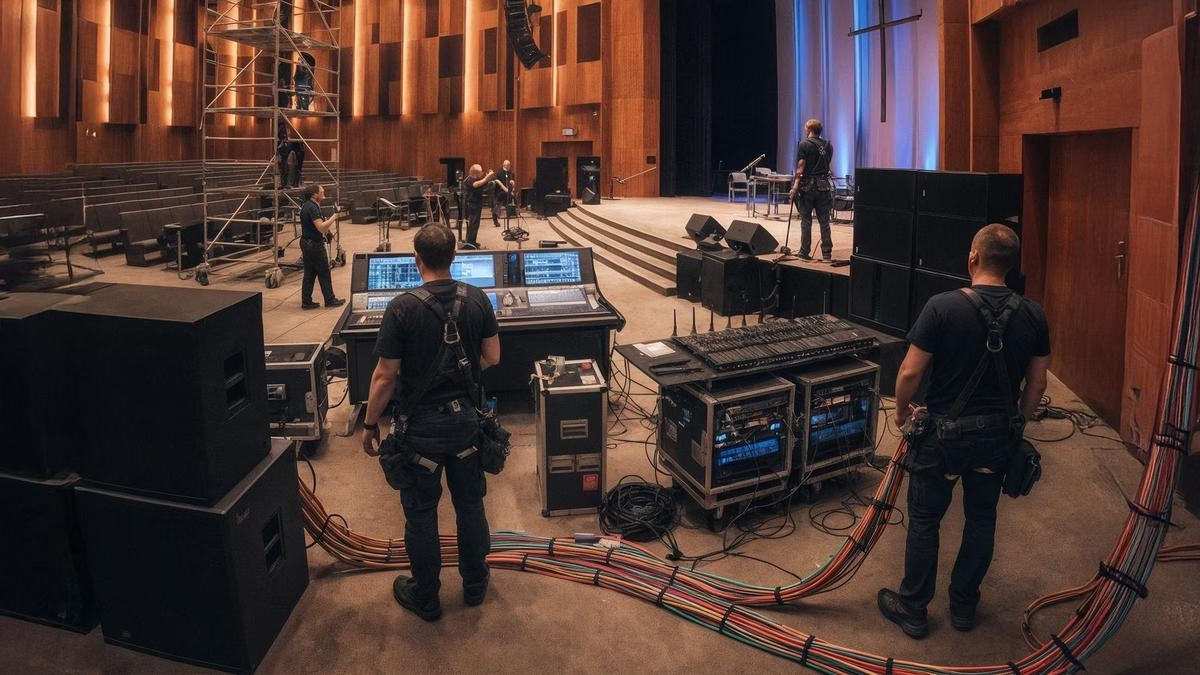
Quick Summary:
If you’re leading a megachurch, your sound system must do more than just play loud. It needs to carry every note, word, and prayer to every seat—and every livestream. I get it: bad sound can wreck the message. You need clear gear, smart setup, and room-ready plans. In this post, I’ll walk you through the key parts that make it all work—and avoid Sunday sound fails.
Start with a mixer, amps, speakers, mics, and signal processors. That’s your base.
Each part helps people hear the word, the song, or the prayer.
Echo makes words unclear and music harsh—fix this or people tune out fast.
Start by clapping in key spots. Big ring? Too much reverb. No ring? You’re fine.
Use soft panels on back walls. Aim them to catch high notes and tame low booms.
Do not soundproof; shape sound. Think foam, cloth, and slat walls, not brick.
Bad reverb turns songs sad. One church I helped heard five echoes on one “Amen.”
Use modeling tools to map bounce zones before you buy gear. They save time and cost.
Match colors and shapes of panels so they don’t ruin your space’s look.
For big rooms that switch use, I design moving panels and ceiling baffles that roll.
Line arrays give the best sound for megachurches.
These systems work by stacking small speakers in a tall line. They focus sound forward and down. That helps reach every seat, even the back row and balcony.
Point-source speakers spread sound in all ways at once. In big rooms, this makes sound bounce. Echoes grow and you lose clarity.
To fix this, we use line arrays with delay towers. Delay towers help match sound speed between front and back.
I also tune each speaker to fit the room. If I don’t, your soprano will sound lost. That’s why loudspeaker calibration matters.
When your altos vanish or sound weak, we likely have a phase problem. Fixing phase keeps all singers clear.
If your choir is stuck in a corner, I’ve seen it. I’ve fixed it with better mic placement and smarter speaker angles.
Your people sing to lift others. I make sure they’re heard.
You need two mixes: one for the room and one for the stream.
Do not treat the livestream as less than. It needs its own mix.
Use a digital console. Set presets for songs, sermons, and alter calls.
Your volunteers are not audio pros. Pick friendly boards they can learn fast.
Bad feedback hurts. Watch gain levels and mic spacing during loud worship.
Build a clear flow map that shows where each signal goes across campus.
Your sound system should always serve both the seat and the screen.
Scalable design starts with smart planning. Build zones now for more rooms later.
Use routing gear that handles changes. Make space for more mics and satellites.
Write good AV plans. Protect your team with solid support deals.
DCMM builds systems that grow as your worship grows.
A great church sound system starts with smart design and the right gear. Mixers, mics, speakers, and amps all play a key part. Fit matters—match your setup to your space and your worship style. Avoid budget-busting mistakes with pro planning and support. At DCMM, we build systems that grow with you and sound great, every time and everywhere. Choose gear that fits now and scales later, so your message always gets through—stage, stream, and beyond. Ready to start your Audio System Design? Contact us today!
DCMM LC © 2025. All Rights Reserved.
Powered by Astrowave | Privacy Policy.